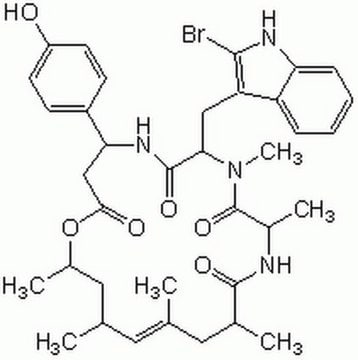420127
Jasplakinolide
from Jaspis johnstoni, ≥90% (HPLC), liquid, Actin polymerization promotor, Calbiochem
Synonyme(s) :
InSolution Jasplakinolide, Jaspis johnstoni
About This Item
Produits recommandés
product name
Jasplakinolide, Jaspis johnstoni, InSolution, ≥90%, 1 mM in DMSO, mammablian cell mitosis inhibitor, potent inducer of actin polymerization and stabilization
Niveau de qualité
Pureté
≥90% (HPLC)
Forme
liquid
Fabricant/nom de marque
Calbiochem®
Conditions de stockage
OK to freeze
desiccated (hygroscopic)
protect from light
Conditions d'expédition
wet ice
Température de stockage
−20°C
Description générale
Actions biochimiques/physiologiques
F-actin
Conditionnement
Avertissement
Forme physique
Reconstitution
Autres remarques
Posey, S.C., and Bierer, B.E. 1999. J. Biol. Chem.274, 4259.
Senderowicz, A.M., et al. 1995. J. Natl. Cancer Inst.87, 46.
Bubb, M.R., et al. 1994. J. Biol. Chem.269, 14869.
Scott, V.R., et al. 1988. Antimicrob. Agents Chemother.32, 1154.
Informations légales
Code de la classe de stockage
10 - Combustible liquids
Classe de danger pour l'eau (WGK)
WGK 1
Point d'éclair (°F)
188.6 °F - closed cup - (Dimethylsulfoxide)
Point d'éclair (°C)
87 °C - closed cup - (Dimethylsulfoxide)
Certificats d'analyse (COA)
Recherchez un Certificats d'analyse (COA) en saisissant le numéro de lot du produit. Les numéros de lot figurent sur l'étiquette du produit après les mots "Lot" ou "Batch".
Déjà en possession de ce produit ?
Retrouvez la documentation relative aux produits que vous avez récemment achetés dans la Bibliothèque de documents.
Les clients ont également consulté
Notre équipe de scientifiques dispose d'une expérience dans tous les secteurs de la recherche, notamment en sciences de la vie, science des matériaux, synthèse chimique, chromatographie, analyse et dans de nombreux autres domaines..
Contacter notre Service technique










